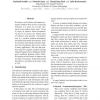2031 search results - page 151 / 407 » Non-symmetric Support Vector Machines |
ICML
2003
IEEE
14 years 9 months ago
2003
IEEE
We present a new method for transductive learning, which can be seen as a transductive version of the k nearest-neighbor classifier. Unlike for many other transductive learning me...
ECML
2004
Springer
14 years 1 months ago
2004
Springer
Random forests are one of the most successful ensemble methods which exhibits performance on the level of boosting and support vector machines. The method is fast, robust to noise,...
ICIP
2010
IEEE
13 years 5 months ago
2010
IEEE
General-purpose no-reference image quality assessment approaches still lag the advances in full-reference methods. Most no-reference methods are either distortion specific (i.e. t...
COLING
2010
13 years 3 months ago
2010
We study a novel shallow information extraction problem that involves extracting sentences of a given set of topic categories from medical forum data. Given a corpus of medical fo...
KDD
2006
ACM
14 years 8 months ago
2006
ACM
Linear Support Vector Machines (SVMs) have become one of the most prominent machine learning techniques for highdimensional sparse data commonly encountered in applications like t...

